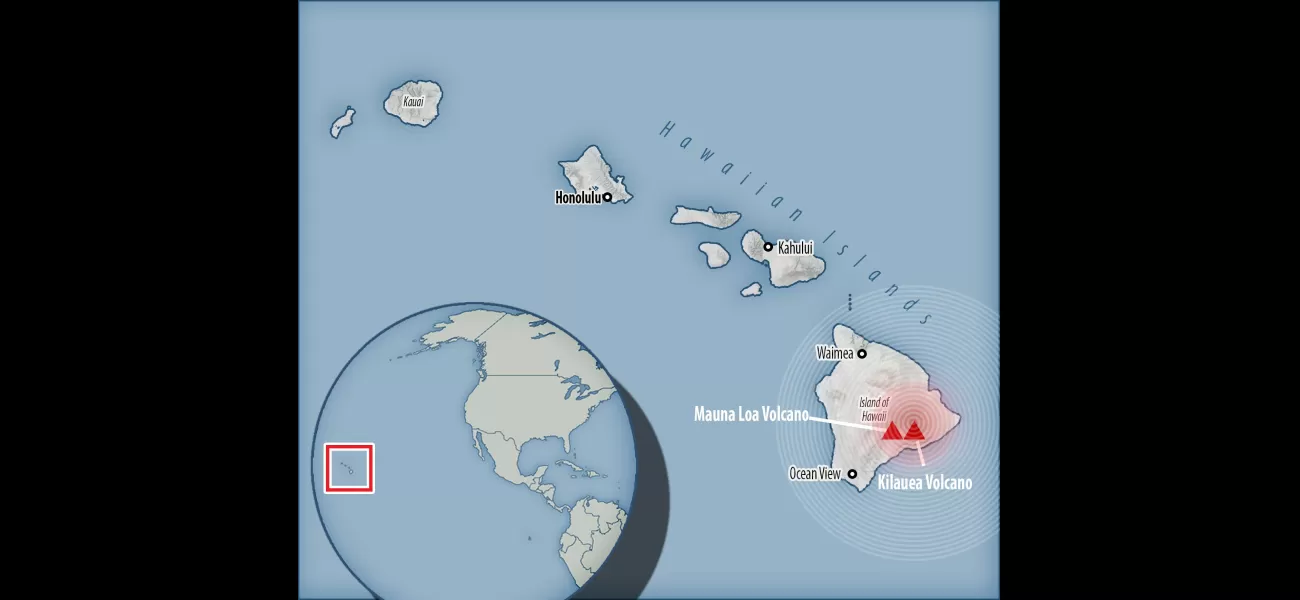New map depicts Hawaiian volcanoes amid current eruption, the first in over four decades.
Recently, the Kīlauea volcano erupted in an area where lava had not flowed since 1974, within Hawaii Volcanoes National Park.
June 4th 2024.

The map displayed the location of the Kīlauea volcano within the beautiful Hawaiian Islands. This volcano had been quiet for almost fifty years, despite being one of the most active volcanoes in Hawaii. However, on Monday, at around 12:30 am local time, the Kīlauea volcano erupted in a section of Hawaii Volcanoes National Park that had last seen an eruption in 1974.
The US Geological Survey's Hawaiian Volcano Observatory reported that the eruption began with lava spewing from fissures about a mile south of the volcano's caldera. Webcams captured the glowing lava flow, indicating that it was in an area that had not been affected by an eruption in almost half a century. The 1974 eruption lasted for six hours and covered a larger area than the current one, but it is uncertain how long this eruption will last.
The eruption appeared to have started a mile south of the Kīlauea caldera, between the Koa'e fault and Hilina Pali Road. As a result, the USGS raised the Volcano Alert Level to warning, and the Aviation Color Code to red. However, eight hours after the eruption, the alert level was lowered to watch, and the color code to orange, due to the small amount of lava and the remote location.
Prior to the eruption, the observatory recorded about 250 earthquakes under the Kīlauea summit, which raised some concerns among scientists. Then, around 12:30 am, lava began to emerge from the summit of this famous volcano, located at Hawaii Volcanoes National Park on the Big Island.
Kīlauea is known as the "youngest and most active volcano" on Hawaii Island, also known as the Big Island. It is situated near the southeastern shore of the island, which is more than 200 miles away from the bustling city of Honolulu on the island of Oahu. According to the National Park Service's website, Kīlauea is a typical shield volcano with long, gentle slopes, and covers an area slightly smaller than Oahu. It is also located on the same island as Mauna Loa, the largest active volcano in the world, and both are within the volcanoes national park.
The recent eruption of Kīlauea did not pose a threat to human life or infrastructure, so there is no travel advisory against visiting Hawaii. The national park remains open, as the affected area is not accessible by foot or vehicle. However, visitors may be able to witness the eruption from other parts of the park. Jessica Ferracane of Hawaii Volcanoes National Park stated that the park is currently open, with the exception of Maunaiki Trail, which is in a remote area.
The eruption occurred a mile south of the Kīlauea caldera, near the Koa'e fault system and Hilina Pali Road, within Hawaii Volcanoes National Park. Inside the caldera is the Halema'uma'u Crater, which erupted on the same date almost a year ago in 2023. Fortunately, the lava was not expected to reach nearby residential areas, but residents were warned to watch out for Pele's hair, which are sharp strands of volcanic glass.
In conclusion, while Kīlauea's new eruption has paused, it is safe to travel to Hawaii, and the national park remains open with a few closures in remote areas. The beautiful and fascinating volcano, located on the Big Island, is a must-see for visitors to Hawaii.
The US Geological Survey's Hawaiian Volcano Observatory reported that the eruption began with lava spewing from fissures about a mile south of the volcano's caldera. Webcams captured the glowing lava flow, indicating that it was in an area that had not been affected by an eruption in almost half a century. The 1974 eruption lasted for six hours and covered a larger area than the current one, but it is uncertain how long this eruption will last.
The eruption appeared to have started a mile south of the Kīlauea caldera, between the Koa'e fault and Hilina Pali Road. As a result, the USGS raised the Volcano Alert Level to warning, and the Aviation Color Code to red. However, eight hours after the eruption, the alert level was lowered to watch, and the color code to orange, due to the small amount of lava and the remote location.
Prior to the eruption, the observatory recorded about 250 earthquakes under the Kīlauea summit, which raised some concerns among scientists. Then, around 12:30 am, lava began to emerge from the summit of this famous volcano, located at Hawaii Volcanoes National Park on the Big Island.
Kīlauea is known as the "youngest and most active volcano" on Hawaii Island, also known as the Big Island. It is situated near the southeastern shore of the island, which is more than 200 miles away from the bustling city of Honolulu on the island of Oahu. According to the National Park Service's website, Kīlauea is a typical shield volcano with long, gentle slopes, and covers an area slightly smaller than Oahu. It is also located on the same island as Mauna Loa, the largest active volcano in the world, and both are within the volcanoes national park.
The recent eruption of Kīlauea did not pose a threat to human life or infrastructure, so there is no travel advisory against visiting Hawaii. The national park remains open, as the affected area is not accessible by foot or vehicle. However, visitors may be able to witness the eruption from other parts of the park. Jessica Ferracane of Hawaii Volcanoes National Park stated that the park is currently open, with the exception of Maunaiki Trail, which is in a remote area.
The eruption occurred a mile south of the Kīlauea caldera, near the Koa'e fault system and Hilina Pali Road, within Hawaii Volcanoes National Park. Inside the caldera is the Halema'uma'u Crater, which erupted on the same date almost a year ago in 2023. Fortunately, the lava was not expected to reach nearby residential areas, but residents were warned to watch out for Pele's hair, which are sharp strands of volcanic glass.
In conclusion, while Kīlauea's new eruption has paused, it is safe to travel to Hawaii, and the national park remains open with a few closures in remote areas. The beautiful and fascinating volcano, located on the Big Island, is a must-see for visitors to Hawaii.
[This article has been trending online recently and has been generated with AI. Your feed is customized.]
[Generative AI is experimental.]
0
0
Submit Comment





